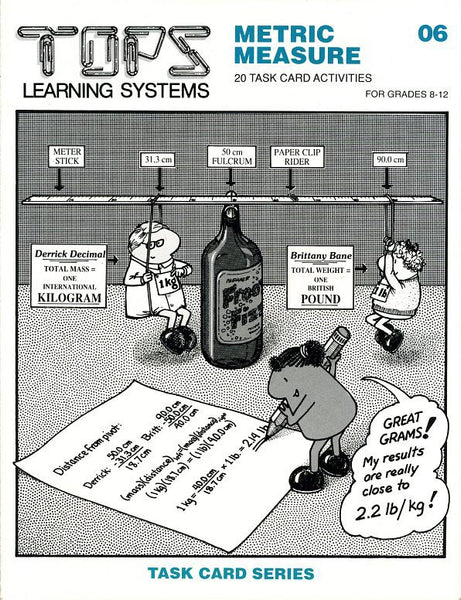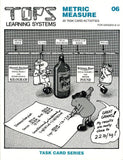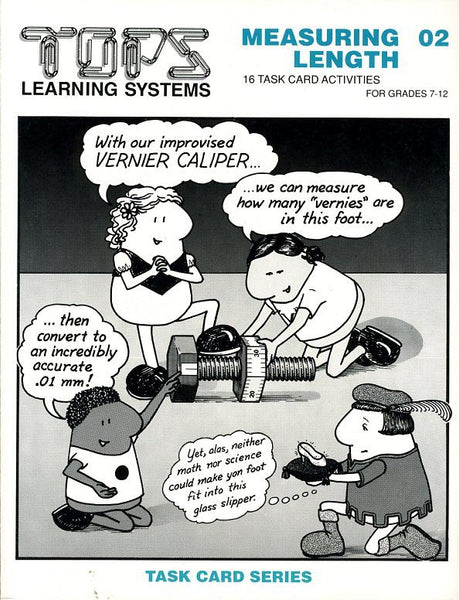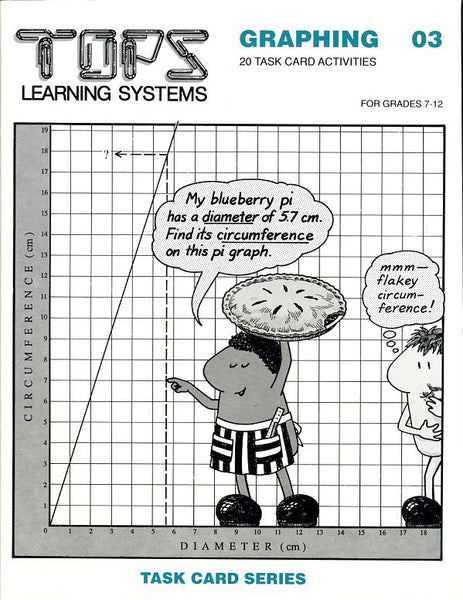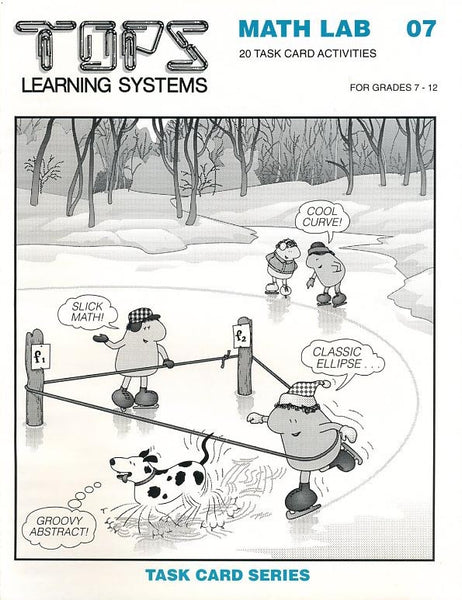#06 Metric Measure (grades 8-12)
Regular price $19.95
Soft-bound, 56 page book, 20 reproducible task cards, full teaching notes.
The perfect sequel to Measuring Length: continue the study of area, volume and mass, and the metric units that measure them. Build metric models that help you visualize the number of stars in the Milky Way. Improvise a sensitive balance to verify that a cubic centimeter holds 1 mL of water and has a mass of 1 gram. By extension, 1000 mL (one liter) has a mass of 1000 grams (one kilogram) or 2.2 pounds. Estimate rice grains by area, volume and mass.
More Information – click any of the tabs below to learn more about this title
Click here for a complete list of materials and convenient shopping.
calculators, scissors, clear tape, kite string, meter sticks, table salt, hand lenses, straight pins, empty cans, eyedroppers, masking tape, 10 mL graduated cylinders, water source, 100 mL graduated cylinders, pie tins or plates (optional), half-gallon milk cartons, paper punch tools, straight straws, paper clips, test tubes, tall beverage bottles, 1 or 2 liter size, plastic produce bags, sandwich bags, gravel or sand, 1 pound bag of long-grained white rice (or other 1-pound reference weights), clothespins, thread, paper cups, U.S. or Canadian dollar bills, baby food jars with lids, paper towels, index cards, newspaper,- Lesson 1: To practice using numeral place values as language, powers of ten, and decimal numbers.
- Lesson 2: To define metric prefixes in terms of the decimal ladder. To practice translating these prefixes to their numerical equivalents.
- Lesson 3: To practice converting common forms of metric units. To understand and use metric abbreviations.
- Lesson 4: To relate increases in length, area and volume to growth in one, two and three dimensions.
- Lesson 5: To model cubic meters, cubic centimeters and cubic millimeters. To comprehend the size of a million and billion in terms of these models.
- Lesson 6: To visualize, with the aid of metric volumes, the number of stars in the Milky Way. To define a personal view of your place in the universe.
- Lesson 7: To calculate the area of a circle, and the volume of a cylinder. To understand volume as area extended through a third dimension.
- Lesson 8: To discover that dry measure in cubic centimeters is equal to liquid measure in milliliters. To appreciate the advantages of using each kind of measure.
- Lesson 9: To calculate the 1 liter water level in a half-gallon milk carton. To prepare heavy duty buckets to use in the next activity.
- Lesson 10: To construct a heavy duty equal-arm balance. To make a kilogram standard derived from the mass of one liter of water.
- Lesson 11: To explore the properties of a balance beam. To understand that the product of mass and distance must be the same on both sides of a centered beam to achieve balance.
- Lesson 12: To apply balance beam properties in determining an equivalency between kilograms and pounds.
- Lesson 13: To construct a light-duty equal-arm balance sensitive to 5 milligrams.
- Lesson 14: To develop a series of milligram masses to use with the light-duty balance previously constructed. To accurately determine the mass of a dollar bill and compare paper densities.
- Lesson 15: To find the mass of rice contained in a baby food jar using a balance beam and graduated cylinder.
- Lesson 16: To estimate the total number of rice grains in a baby food jar by counting the grains in a small mass and multiplying by the whole.
- Lesson 17: To estimate the total number of rice grains in a baby food jar by counting the grains in a small volume and multiplying by the whole.
- Lesson 18: To estimate the total number of rice grains in a baby food jar by spreading all the rice over a centimeter grid, then counting the average number of grains in a typical square.
- Lesson 19: To explain an apparent area gain in a group of puzzle pieces.
- Lesson 20: To use the metric system to estimate how long it takes a dripping faucet to waste a metric ton of water.
We encourage improvisation - it's one of the main goals of our hands-on approach! You and your students might invent a simpler, sturdier or more accurate system; might ask a better question; might design a better extension. Hooray for ingenuity! When this occurs, we'd love to hear about it and share it with other educators.
National Science Education Standards (NRC 1996)
Teachers of science...
A: ...plan an inquiry-based science program. (p. 30)
B: ...guide and facilitate learning. (p. 32)
C: ...engage in ongoing assessment of their teaching and of student learning. (p. 37)
D: ...design and manage learning environments that provide students with the time, space, and resources needed for learning science. (p. 43)
• Represent a central event or phenomenon in the natural world.
• Represent a central scientific idea and organizing principle.
• Have rich explanatory power.
• Guide fruitful investigations.
• Apply to situations and contexts common to everyday experiences.
• Can be linked to meaningful learning experiences.
• Are developmentally appropriate for students at the grade level specified.
Core Concepts/Processes: Once centimeter cube of water occupies one milliliter of volume with a mass of one gram.
Core Inquiries: Estimate the number of rice grains in a jar by volume; by weight; by area. Three different methods yield roughly the same result.
Core Content: Objects have length, area, volume and mass quantified and measured with metric prefixes.
Core Content: If each grain of salt represents a star like our sun, and 8 tiny grains fit into a cubic millimeter, the stars in our Milky Way galaxy fill 25 cubic meters.
TEACHING Standards
These 20 task cards promote excellence in science teaching by these NSES criteria:Teachers of science...
A: ...plan an inquiry-based science program. (p. 30)
B: ...guide and facilitate learning. (p. 32)
C: ...engage in ongoing assessment of their teaching and of student learning. (p. 37)
D: ...design and manage learning environments that provide students with the time, space, and resources needed for learning science. (p. 43)
CONTENT Standards
These 20 task cards contain fundamental content as defined by these NSES guidelines (p. 109).• Represent a central event or phenomenon in the natural world.
• Represent a central scientific idea and organizing principle.
• Have rich explanatory power.
• Guide fruitful investigations.
• Apply to situations and contexts common to everyday experiences.
• Can be linked to meaningful learning experiences.
• Are developmentally appropriate for students at the grade level specified.
Unifying Concepts and Processes
NSES Framework: Systems, order, and organization • Evidence, models and explanation • Constancy, change, and measurementCore Concepts/Processes: Once centimeter cube of water occupies one milliliter of volume with a mass of one gram.
Science as Inquiry (content standard A)
NSES Framework: Identify questions that can be answered through scientific investigations. • Design and conduct a scientific investigation. • Use appropriate tools and techniques to gather, analyze, and interpret data. • Develop descriptions, explanations, predictions, and models using evidence. • Think critically and logically to connect evidence and explanations. • Recognize and analyze alternative explanations and predictions. • Communicate scientific procedures and explanations. • Use mathematics in all aspects of scientific inquiry.Core Inquiries: Estimate the number of rice grains in a jar by volume; by weight; by area. Three different methods yield roughly the same result.
Physical Science (content standard B)
NSES Framework: Properties and changes of properties in matterCore Content: Objects have length, area, volume and mass quantified and measured with metric prefixes.
Earth and Space Science (content standard D)
NSES Framework: Origin and evolution of the universeCore Content: If each grain of salt represents a star like our sun, and 8 tiny grains fit into a cubic millimeter, the stars in our Milky Way galaxy fill 25 cubic meters.

